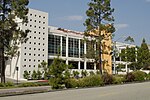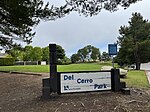Peninsula Center (mall)
Peninsula Center is a shopping center in Rolling Hills Estates, California on the affluent Palos Verdes Peninsula in Greater Los Angeles. Developer Jerry Moss and it opened in phases from May 1961 through to 1965.Tenants during the opening years included a 52,000-square-foot (4,800 m2) J. J. Newberry variety store (May 1961, Lucky Supermarkets (October 1962), Fox Theater and Buffums department store (1963), the first major department store to open on the Palos Verdes Peninsula. By 1965 the center had 65 stores and 200,000 square feet (19,000 m2) of gross leasable area. Peninsula Center hosted the Miss Peninsula Center beauty contest on May 22, 1965. In late June 1965, Peninsula Raceways opened near Buffums, in response to the slot car racing craze that reached its zenith that year.
Excerpt from the Wikipedia article Peninsula Center (mall) (License: CC BY-SA 3.0, Authors).Peninsula Center (mall)
Hawthorne Boulevard,
Geographical coordinates (GPS) Address Nearby Places Show on map
Geographical coordinates (GPS)
| Latitude | Longitude |
|---|---|
| N 33.7747403 ° | E -118.3764286 ° |
Address
Rite Aid
Hawthorne Boulevard
90274 , Rolling Hills Estates
California, United States
Open on Google Maps







